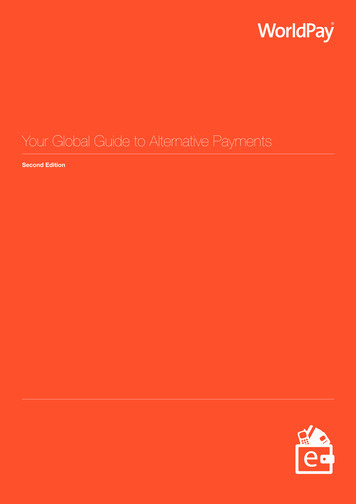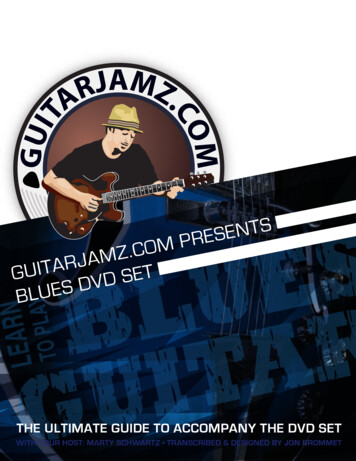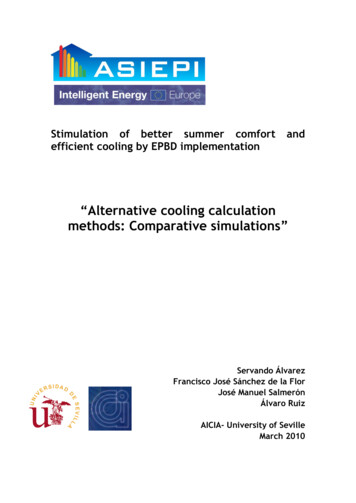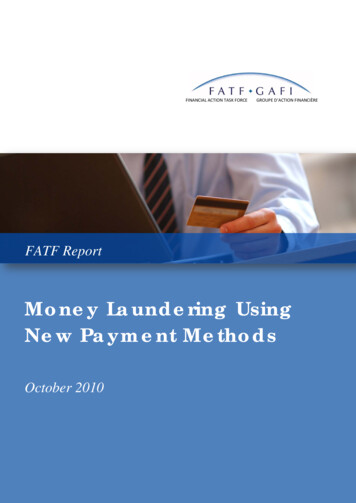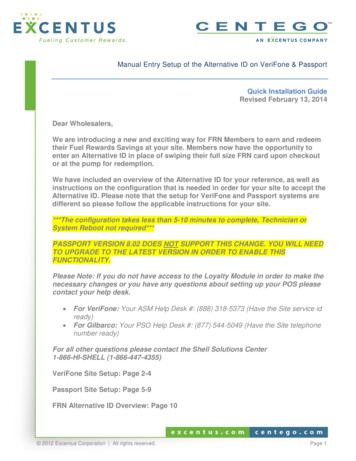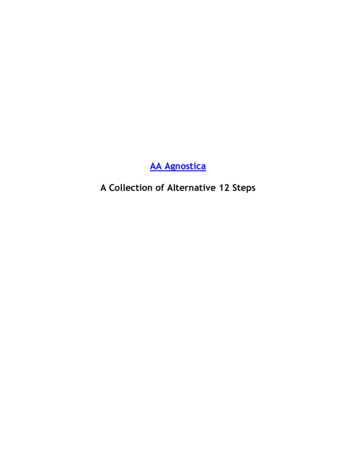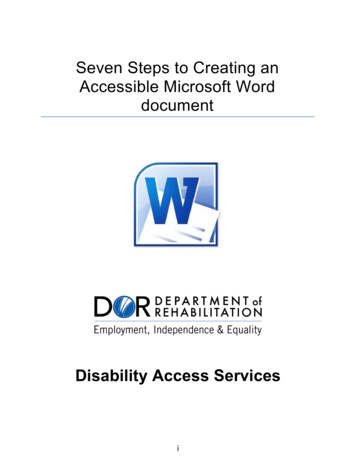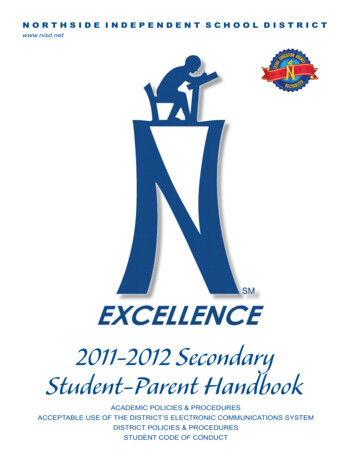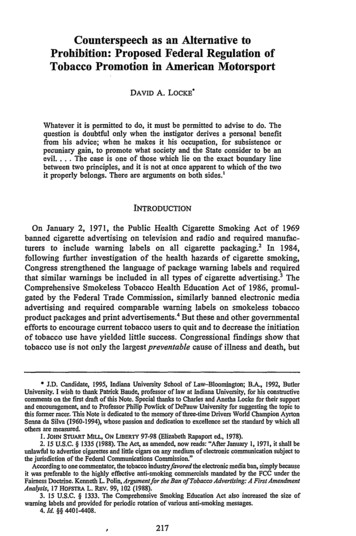
Transcription
Counterspeech as an Alternative toProhibition: Proposed Federal Regulation ofTobacco Promotion in American MotorsportDAVID A. LOCKE*Whatever it is permitted to do, it must be permitted to advise to do. Thequestion is doubtful only when the instigator derives a personal benefitfrom his advice; when he makes it his occupation, for subsistence orpecuniary gain, to promote what society and the State consider to be anevil. The case is one of those which lie on the exact boundary linebetween two principles, and it is not at once apparent to which of the twoit properly belongs. There are arguments on both sides.'INTRODUCTIONOn January 2, 1971, the Public Health Cigarette Smoking Act of 1969banned cigarette advertising on television and radio and required manufacturers to include warning labels on all cigarette packaging.2 In 1984,following further investigation of the health hazards of cigarette smoking,Congress strengthened the language of package warning labels and requiredthat similar warnings be included in all types of cigarette advertising.' TheComprehensive Smokeless Tobacco Health Education Act of 1986, promulgated by the Federal Trade Commission, similarly banned electronic mediaadvertising and required comparable warning labels on smokeless tobaccoproduct packages and print advertisements. But these and other governmentalefforts to encourage current tobacco users to quit and to decrease the initiationof tobacco use have yielded little success. Congressional findings show thattobacco use is not only the largest preventable cause of illness and death, but* J.D. Candidate, 1995, Indiana University School of Law-Bloomington; B.A., 1992, ButlerUniversity. I wish to thank Patrick Baude, professor of law at Indiana University, for his constructivecomments on the first draft of this Note. Special thanks to Charles and Anetha Locke for their supportand encouragement, and to Professor Philip Powlick of DePauw University for suggesting the topic tothis former racer. This Note is dedicated to the memory of three-time Drivers World Champion AyrtonSenna da Silva (1960-1994), whose passion and dedication to excellence set the standard by which allothers are measured.1. JOHN STUART MILL, ON LIBERTY 97-98 (Elizabeth Rapaport ed., 1978).2. 15 U.S.C. § 1335 (1988). The Act, as amended, now reads: "After January 1, 1971, it shall beunlawful to advertise cigarettes and little cigars on any medium of electronic communication subject tothe jurisdiction of the Federal Communications Commission."According to one commentator, the tobacco industryfavored the electronic media ban, simply becauseit was preferable to the highly effective anti-smoking commercials mandated by the FCC under theFairness Doctrine. Kenneth L. Polin, Argumentfor the Ban ofTobacco Advertising: A FirstAmendmentAnalysis, 17 HOFsTRA L. Rav. 99, 102 (1988).3. 15 U.S.C. § 1333. The Comprehensive Smoking Education Act also increased the size ofwarning labels and provided for periodic rotation of various anti-smoking messages.4. Id. §§ 4401-4408.
INDIANA LAW JOURNAL[Vol. 70:217also the number one underlying cause of death in the United States today,resulting in more than 450,000 deaths each year.Because congressional legislation has regulated tobacco advertising only incertain areas, such as television, radio, and print advertisements, tobaccomanufacturers have tended to transfer promotional spending to areas notsubject to restriction. Companies such as Philip Morris and R.J. Reynoldshave invested heavily in sponsoring sporting events, underwriting the cost ofevents as well as that of billboards, print ads, and other advertising mediarelated to the promotion and marketing of such events.( Since the advent ofthe ban on television cigarette advertising, corporate tobacco sponsors haveeffectively circumvented the prohibition through active promotion of theirproducts at televised sporting events.7 One of the most visible sports ontelevision is motor racing,8 with media coverage of the sport paralleling therapid growth of the tobacco industry's promotional efforts. Indianapolis 500winner Bobby Rahal put it succinctly: "Today, I'd say that 90 percent of thesponsors are not auto-related . Tobacco companies cannot advertise ontelevision, but when there is an Indy car race televised, the logo is seeneverytime [sic] the camera focuses in on a car."9 Second only (in attendanceand viewership) to football as a spectator sport in the United States, 0 racinghas become one of the more glamorous means by which tobacco companiesmaintain visibility" in the face of gradually declining sales.'In recent years, congressional activity has centered on the rising percentageof tobacco advertising and promotional expenses transferred to activities notcurrently required to display health warnings.' Representative Mike Synar5. H.R. 2147, 103d Cong., 1st Sess. § 2 (1993).6. Susan A. Wichmann & D.R. Martin, Sports and Tobacco: The Smoke Has Yet to Clear,PHYSICIAN & SPORTSMEDICINE, Nov. 1991, at 125, 126; CENTERS FOR DISEASE CONTROL, CIGARETrEADVERTISING-UNrIrED STATES, 1988 39 MMWR 261 (1990) ("In 1988, cigarette advertising andpromotional expenditures related to the sponsorship of sporting events were 84.0 million . andincluded sponsorship, newspaper advertising, and other expenditures.").7. Wichmann & Martin, supra note 6, at 126-27. Alan Davis, then-vice president for public issuesat the American Cancer Society, claimed that "[s]ports sponsorships have always been the tobaccoindustry's way of keeping its name in front of the active, sporting youth of America." Id.8. The ESPN cable sports network now televises an average of 65 races (not counting reruns) eachyear, including Formula One, IndyCar, NASCAR, IMSA, NHRA, and IHRA events. Michael Vega, TheStocks are Rising, BOSTON GLOBE, July 9, 1993, at 59.9. William D. Murray, CART's Future Cloudy at Best, UPI, Oct. 4, 1985, available in LEXIS,News Library, ARCNWS File.10. Alan Blum, The Marlboro Grand Prix: Circumvention of the Television Ban on TobaccoAdvertising, 324 NEW ENG. J. MED. 913, 914 (1991).11. A study conducted by a trade magazine found that 75% of the more than 80 million tobaccocompanies spend each year on "event" sponsorships goes to sports. For R.J. Reynolds, manufacturer ofWinston and Camel cigarette brands and one of the largest tobacco marketers in the United States, thebiggest sport has been auto racing. Jeanne Whalen, Cigarette Interest Flags in Racing, ADVERTISINGAGE, Dec. 6, 1993, at 28.12. According to one journalist, "The number of cigarettes sold in the USA has dropped each yearsince 1981 and is expected to continue falling 2% to 3% a year." James Cox, Tobacco Issue Still Burns,USA TODAY, June 25, 1992, at BI, B2. Philip Morris reports that its domestic tobacco shipments fell2.9% against a total domestic industry shipment decline of 0.5%. PHILIP MORRIS COMPANIES, INC., 1992ANNUAL REPORT 16 (1993).13. H.R. 3614, 103d Cong., 1st Sess. § 3 (1993).
1994]COUNTERSPEECH(D-OK) first introduced legislation in 1986 seeking a total ban on advertisingand promotion of tobacco products, 4 and versions of the Bill receivedconsideration through the 1990 session. 5 Following a brief period duringwhich tobacco advertising legislation lay dormant, proponents of restrictionhave renewed their efforts, hoping to capitalize on current political interest inhealth issues.' 6 While congressional proponents of restrictions on tobaccoadvertising assert that tobacco companies use promotional activities in suchsports as motor racing to attract minors, 7 spokespersons for the tobaccocompanies maintain that their advertising and promotions are intended onlyto increase brand loyalty or to persuade existing smokers to change brands.' 8Regardless of the motives, one thing is clear: Corporate use of motorsportsas a commercial tool to sell tobacco products is at the center of a growingFirst Amendment debate. 9 Both sides of the controversy claim that restriction or prohibition of tobacco advertising is an issue that goes beyondcommercial speech and the right to market a lawful product. For advocates offree speech, the question is whether a society should manipulate its citizens'behavior by censoring the type of information they receive.20 Proponents ofrestriction or prohibition, however, point out that the issue is not one ofcensorship, but rather a matter of good health principles and sound planningfor the well-being of future generations. 2'After years of empirical study, the adverse effects of tobacco use on humanhealth are well documented.22 Health hazards of the magnitude associatedwith tobacco use clearly implicate the federal government's substantial14. H.1L 4972, 99th Cong., 2d Sess. (1986).15. H.R. 5041, 101st Cong., 2d Sess. (1990); H.R. 1493, 101st Cong., 1st Sess. (1989); H.R. 1532,100th Cong., 1st Sess. (1987); H.R. 1272, 100th Cong., 1st Sess. (1987).16. H.R. 3614, supra note 13; H.R. 2147, supra note 5. When the House of Representativesadjourned from the second and final session'of the 103d Congress on October 7, 1994, no action hadbeen taken on either House Bill 3614 or House Bill 2147. Presumably, comparable legislation will beintroduced during the 104th Congress.17. H.R. 5041, supra note 15, § 2; see also H.R. 3614, supra note 13, § 2.18. Janis Carr, Sponsorship HardHabit to Break: Marriageof Tobacco, Alcohol and Sports underAttack CHI. TRIB., Oct. 23, 1988, at 18; see also Wes Raynal, Butt Out: Smoking Foes Want TobaccoOut ofRacing, Others See It As Infringing Free Speech, AUTOWEEK, May 30, 1994, at 18, 20.19. See, e.g., Tobacco Issues: Hearings on California's Antismoking Advertisements andShareholder Attempts to Stop Cigarette Advertising Before the Subcomm. on Transportation andHazardous Materials of the House Comm. on Energy and Commerce, 101st Cong., 2d Sess. 56-89(1990) (statements of Beth W. Bressan, vice president and assistant to the president of theCBS/Broadcast Group; Richard P. Gitter, vice president of advertising standards of the NBC TelevisionNetwork; Alfred R. Schneider, vice president of policy and standards of Capital Cities/ABC, Inc.; EdwinM. Durso, senior vice president and general counsel of ESPN, Inc.) (addressing the amount of broadcasttime dedicated to the coverage of motorsports).20. Tape of Conference on Commercial Speech and the First Amendment, held by BostonUniversity's College of Communication through its Institute for Democratic Communication, FreeSpeech and Advertising- Who Draws the Line? (Apr. 1987) [hereinafter FreeSpeech and Advertising].The tape carries the message, "This program was made possible by a grant from Philip Morris U.S.A."Former FTC Chairman Michael Pertschuk declined an invitation to participate in the conference,saying, "'It's as if the Mafia had sponsored a colloquium on RICO [the Racketeer Influenced andCorrupt Organizations law]."' LARRY C. WHrrE, MERCHANTS OF DEATH: THE AMERICAN TOBACCOINDUSTRY 220 (1988).21. Free Speech and Advertising, supra note 20.22. H.R. 2147, supra note 5, § 2.
INDIANA LAW JOURNAL[Vol. 70:217interest in protecting its citizens' health, particularly that of minors. Thevarious legislative proposals currently under consideration range from outrightprohibition of tobacco promotion to partial restriction. But only the latterscheme, which would compel dissemination of counterspeech about the healtheffects of tobacco use in proportion to the sponsor's commercial involvement,would further the federal government's substantial interest in a mannerconsistent with the principles of the First Amendment. This type of legislationwould meet the constitutional standard of narrowly tailoring the restrictionand would advance a First Amendment interest in giving the people moreinformation rather than less.This Note analyzes the constitutional issues implicated in the restriction oftobacco sports advertising and promotion in light of current Supreme Courtcommercial speech doctrine. Specifically, this Note addresses the probableimpact of tobacco advertising regulation on the sport of motor racing byhighlighting current tobacco company involvement. Part I considers thecompeting interests involved in the marriage of tobacco and motorsports. PartII discusses the history of tobacco advertising legislation, tracking the changesfrom House Bill 1493 through the most recent examples, House Bill 3614 andthe alternative Food and Drug Administration ("FDA") bill, House Bill 2147.Part III tests the constitutionality of the various legislative schemes. This Noteconcludes that although a congressional ban on tobacco sports advertising andpromotion passes constitutional muster under the commercial speech doctrine,legislation which compels counterspeech offers the superior alternative byadvancing the interests of the First Amendment.I. COMPETING INTERESTS IN THE TOBACCOMOTORSPORTS MARRIAGEMembers of the racing community typically are willing to overlook theapparent contradiction between athletic activity and tobacco use because ofthe massive support American motorsports receives from corporate tobaccosponsorship.23 Most racers assert the right of a manufacturer to market alegal product without interference from the federal government.2" But for theanti-tobacco forces, the link between tobacco sports promotion and the imageof sport is overly persuasive, particularly in the case of adolescents, and mustbe eliminated as a first step toward resolving the tobacco problem. For thoseopposed to tobacco use, the effect of lost tobacco sponsorship on motorsportsis irrelevant." This Part examines both the nature of tobacco's relationship23. Following the 1993 Indianapolis 500, Emerson Fittipaldi commented from the winner's circle,"Marlboro is back up." Bob Oates, See Through the Smoke-Don't Ban Cigarettes, Ban CigarettePromotion, L.A. TIMEs, May 1, 1994, at C3, C9. Fittipaldi, a two-time Indianapolis 500 winner (1989& 1993) and two-time Drivers World Champion (1972 & 1974), employs a personal trainer and followsa strict dietary regimen to maintain peak physical conditioning. Like most top racing drivers, Fittipaldidoes not use tobacco products.24. See infra note 46.25. Proponents of a ban on tobacco sports promotion decry the complicity of the motorsportscommunity. Recently, a reporter for the Los Angeles Times summarized the viewpoint, askingrhetorically "whether a sport deserves to exist if it can't operate without creating addicts to a deadlysubstance." Oates, supra note 23, at C9.
1994]COUNTERSPEECHwith motorsports and the results of studies on the link between tobaccopromotion and consumption.A. Sporting and Commercial InterestsFor the partners in the tobacco-motorsports marriage, the union clearly ismutually beneficial. In the early 1970's when R.J. Reynolds began itsassociation with the National Association of Stock Car Auto Racing("NASCAR"), racing was largely a regional sport.26 NASCAR president BillFrance, Jr., credits R.J. Reynolds with the sport's rise to national prominence,not only because of the company's promotional efforts, but through itsexample that racing sponsorship need not come solely from manufacturers ofautomotive-related products.27 R.J. Reynolds' pioneering efforts have helpedchange the face of racing in the years since the advent of the televisionadvertising ban.28 In return, motor racing enthusiasts are particularlyappreciative of those who support their sport:Both CART and NASCAR point to studies that show auto racing fansare the "most loyal" of fans who attend sporting events. One survey foundthat 61 percent of race fans say their purchasing decisions would beinfluenced by a company's support of motorsports. This factoid isparamount in building brand recognition and corporate identity.26. Vega, supra note 8, at 59.27. Id. Although NASCAR's affiliation with R.J. Reynolds marked the beginning of tobaccocompany involvement with motorsports in the United States, the British Lotus Grand Prix team set thetone for corporate tobacco sponsorship in 1968, following the British ban on television advertising ofcigarettes. A British Broadcasting Company ("BBC") documentary notes that "[Lotus team owner] ColinChapman took out a competition license in the name of Gold Leaf Team Lotus, and sprayed the carsred and white, like a Gold Leaf package, and really, that was the start of real money in motor racing."The Power and the Glory: The Revolutionaries (BBC Lionheart Television, 1991) (remarks of JohnCooper, former owner of the now-disbanded Cooper Grand Prix racing team).28. According to one periodical, R. Reynolds "spends more than 20 million each year on autoracing." Geoffrey N. Smith, Daytona Dreaming, FINANCIAL WORLD, Apr. 12, 1994, at 10. A chartaccompanying a recenf newspaper article partially documents the investment of cigarette companies inAmerican motorsports since the enactment of the Public Health Cigarette Smoking Act of 1969. Through1991, R.J. Reynolds spent the following amounts on event and series point funds: NASCAR WinstonCup Series, 17.2 million (1971-1991); IMSA Camel GT, 6.0 million (1971-1991); NHRA WinstonDrag Racing, 8.8 million (1974-1991); Camel Pro Series, 3.6 million (1974-1991); Camel Supercross, 0.4 million (1989-1991); TOTAL: 36.0 million. For Philip Morris, event and series point fund moneypaid in the CART IndyCar series amounted to the following: Marlboro Challenge, 4.9 million (19871991); Marlboro 500, 3.8 million (1987-1989); Marlboro Championship Trail, 1.1 million (19701991); TOTAL: 9.8 million. The author notes that these dollar figures do not include team sponsorshipfees. Research indicates that Philip Morris sponsorship of the Marlboro Racing Team has required aninvestment of 10.0 million per year since 1986. Selena Roberts, Making Sport of CigaretteAd Law?Critics Chargethe Tobacco Industry's Sponsorship ofMotor Sports is an Advertising Tool that HurtsYoungsters, ORLANDO SENTINEL TRIB., May 25, 1992, at Al.Since 1991, Philip Morris' Marlboro sponsorship has gone to the Penske IndyCar team, which rantwo cars painted in the distinctive red chevron logotype during the 1992 and 1993 seasons. Accordingto Ernie Saxton, publisher of Motorsports Marketing News, the addition in 1994 of a third MarlboroPenske car for Al Unser, Jr., represented an 8.0 million commitment by Philip Morris. Whalen, supranote 11, at 28.
INDIANA LA W JOURNAL[Vol. 70:217It is not unreasonable to say motorsports' growth benefited greatlywhen Phillip Morris [sic] and R.J. Reynolds took their advertising show tothe road courses and ovals.29Market share is of great importance to companies in a declining, "mature"market such as tobacco,3 and despite some recent reductions in event and31series sponsorship designed to optimize investment, tobacco companieshave no intention of voluntarily relinquishing the exposure gained throughtheir association with motorsports.32 Specifically, television coverage ofracing events with which tobacco products are associated affords tobacco33marketers promotional opportunities that money cannot buy directly. AMichigan research firm that provides documentation of the amount ofexposure sponsors obtain during nationally televised sporting events showsthat in 1993, tobacco companies participating in the various major Americanracing series received a total of nearly thirty-four hours of televised in-focusexposure time. 34 The firm, Joyce Julius and Associates, Inc., defines in-focus29. Dutch Mandel, Racingfor Dollars: Corporate America Likes the Return on Investment inMotorsports, AUToWEEK, Dec. 4, 1989, at 61, 65-66. CART is an acronym for Championship AutoRacing Teams, the organizing body of the 16-race IndyCar series.30. A mature market is, in essence, a no-growth market that necessarily decreases in size throughconsumer attrition. Tobacco companies insist that market expansion is not a corporate goal. See, e.g.,Tobacco Advertising: Hearings on H.R. 1272 and H.R. 1532 Before the Subcomm. on Health and theEnvironment of the House Comm. on Energy and Commerce, 100th Cong., 1st Sess. 113-17 (1987)[hereinafter Hearings on H.R. 1272 and H.R. 1532] (statement of Scott Ward, professor of marketing,the Wharton School, University of Pennsylvania). But see Tobacco Control and Marketing: Hearingson H.R. 5041 Before the Subcomm. on Health and the Environment ofthe House Comm. on Energy andCommerce, 101st Cong., 2d Sess. 385 (1990) [hereinafter Hearingson H.R. 5041] (statement of MarkGreen, commissioner of consumer affairs, New York City) ("Advertising experts agree that marketexpansion, especially for an industry that loses over two million consumers a year who die or quit, isan important objective of nearly all advertising.").31. Whalen, supra note I I, at 28. RI. Reynolds ended its 22-year Camel association with theInternational Motor Sports Association ("IMSA") at the close of the 1993 season.' Though it had beenrumored that R.J. Reynolds would pull the Camel sponsorship due to an imminent change in thespecifications of the series' prototype cars (which reduced media coverage), R.J. Reynolds ProgramManager Larry Kiger cited the price wars between Reynolds and Philip Morris, stating that "'[thedecision was not driven by what's going on or what's not going on in sports car racing. Our marketingneeds changed drastically over the past two years, which has changed the way we must market ourproduct."' Camel Out, Exxon In, ON TRACK, Oct. 22, 1993, at 7.32. Attendance at American racing events has steadily increased in recent years. In 1993, majorracing series with tobacco company involvement yielded the following total attendance statistics, with1992 totals in parentheses: NASCAR Winston Cup stock cars-4,020,220 (3,699,833); CART IndyCar& USAC Indianapolis 500-3,064,180 (2,946,327); NHRA Winston Drag Racing-,738,000(1,598,003); IMSA Camel GT prototype cars--587,500 (716,500); NASCAR Winston West stockcars-480,500 (441,400). GOODYEAR TIRE & RUBBER CO., 1993 AUTO RACING ATrENDANCE 7 (1994).33. Alison Muscatine, Sports and Tobacco: Relationship under Fire, L.A. TIMES, Apr. 28, 1991,at CI (quoting Northeastern University law professor Richard Danar).34. JOYCE JULIUS & ASSOCIATES, 11 SPONSORS REPORT No. 20, 1993 PPG INDYCAR WORLDSERIES YEAR-END REPORT, at 2,4-6 (1993) [hereinafter INDYCAR YEAR-END REPORT]; JOYCE JULIUS& ASSOCIATES, 9 SPONSORS REPORT NO. 32, 1993 NASCAR/WINSTON CUP YEAR-END REPORT, at 2-5(1993) [hereinafter NASCAR/WINsTON CUP YEAR-END REPORT]; JOYCE JULIUS & ASSOCIATES, 8SPONSORS REPORTNO. 12, 1993 IMSA CAMEL GT YEAR-END REPORT, at 2-4 (1993) [hereinafter IMSACAMEL GT YEAR-END REPORT]; JOYCE JULIUS & ASSOCIATES, 8 SPONSORS REPORT No. 20, 1993NHRA/WINsTON DRAG RACING SERIES YEAR-END REPORT, at 4,6 (1993) [hereinafter NHRAIWINSTONDRAG RACING SERIES YEAR-END REPORT].
COUNTERSPEECH1994]exposure time as that which "is realized when a sponsor's name or logo canbe readily identified by an unbiased observer., 35 Additionally, the firm'sstatistics show that in the various major forms of racing discussed above,tobacco company sponsors' "names, product(s), or clearly recognizableslogan(s) ' 36 received televised mention no fewer than 3675 times during the1993 season.37For the beneficiaries of tobacco sports advertising, the fact that tobaccocompany names and logos appear on television is incidental to the marketcompetition and bears no relation to the 1971 television ad ban. Roger Penske,president of the Penske Racing IndyCar team, analogizes the competitivenature of advertising to that of racing:Barring or banning, in America, the free expression of someone youdisagree with is not consistent with my view of allowing someone to freelyand openly compete on their merits . whether on the race track or in themarketplace.As long as cigarettes are a legal product, tobacco companies shouldhave every right to promote their products-right alongside sparkplugs andmotor oil-by sponsoring Indy race car drivers and teams. Selectivelybanning the promotion of a particular product because some people do notapprove of that product would set a dangerous precedent.33The tobacco industry denies that television coverage is the raison d'dtre forits motorsports sponsorships, pointing instead to the demographics of the fanswho typically attend races.39 Nat Walker, public relations spokesman for R.J.Reynolds, notes that "[p]eople who attend [motorsports] events have a higherSources of in-focus exposure include car identity, uniforms, helmets/hats, shirts, billboards, signs,retaining walls, pit identification, starter's stand, television screen graphics, car transporters, flags,banners, message boards, and scoreboards.35. JoYce JuLIus & AssocIATEs, SPONSORS REPORT REFERNcE GUIDE (1993).36. Id.37. The Sponsors Report determines the value of a sponsor's television exposure by rating verbalreferences at 10 seconds each. After the in-focus time and the verbal reference time are added together,the dollar value received is calculated based upon the non-discounted cost of the individual broadcast'sadvertising rate for a 30 second commercial.By individual series, tobacco manufacturers received the following televised values: IndyCar-7 hirs.,31 min., 21 sec. of in-focus exposure (5% over 1992), 98 sponsor mentions (32% under 1992), and 18,523,225 in value (45% over 1992), INDYCAR YEAR-END REPORT, supra note 34, at 2, 4-6;NASCAR-16 hrs., 5 min., 27 see. of in-focus exposure (14% over 1992), 1918 sponsor mentions (23%under 1992), and 31,379,755 in value (96% over 1992), NASCAR/WINSTON CUP YEAR-END REPORT,supra note 34, at 2-5; IMSA-3 hrs., 39 min., 57 sec. of in-focus exposure (33% over 1992), 689sponsor mentions (23% under 1992), and 2,923,890 in value (10% under 1992), IMSA CAMEL GTYEAR-END REPORT, supra note 34, at 2-4; NHRA-6 his., 27 min., 15 sec. of in-focus exposure, 970sponsor mentions, and 4,639,220 in value (1992 figures not available), NHRA/WINsToN DRAG RACINGSERIES YEAR-END REPORT, supra note 34, at 4, 6.38. Hearings on H.R. 5041, supra note 30, at 783 (statement of Roger S. Penske, president andCEO, Penske Corporation; president and founder, Penske Racing, Inc.; director, Championship AutoRacing Teams, Inc. ("CART')). It should be noted that at the time of his testimony before Congress,Mr. Penske was a member of the board of directors of Philip Morris Companies, Inc., parent companyof CART sponsor Marlboro. PI.UP MORRIS COMPANIES, INC., SEC 10-K 5 (1989).39. Skip Wollenberg, TobaccoFirms Woo Audience in Racing, INDIANAPOLIS STAR, May 28, 1994,at BS.
INDIANA LAW JOURNAL[Vol. 70:217incidence of smoking than the general population."4 Similarly, Philip Morrisexecutive Ellen Merlo maintains that her company would be involved withracing anyway, even if the sport were not televised at all.4 Notwithstandingthat those who attend racing events tend to fit the tobacco industry's targetmarket, it is a safe assumption that tobacco companies, when justifyingpromotional expenditures, entertain the possibility that their brands will beseen or mentioned on television.42Despite findings by certain members of Congress that the tobacco industryis unwilling to alter its marketing practices to minimize the impact onminors,43 there are indications that tobacco companies are moving towardself-regulation (or moderation) to protect their financial stake in motorsportfrom government intervention. Philip Morris' recent agreement with the cityof New York to devote a substantial percentage of its billboard space to ananti-smoking campaign for minors-in return for the right to sponsor thestillborn Marlboro Grand Prix-would have been unthinkable five yearsago.44 Another example, though considerably less noteworthy, was R.J.Reynolds' effort to deemphasize the Camel brand name in its NASCAR andNHRA sponsorships in 1994 by switching to "Smokin' Joe's Racing Team"labels and reducing the size of the Camel name.45While members of the tobacco industry and the racing fraternity generallyagree that a ban on sports tobacco advertising would have some initial impacton American motorsports, there is little consensus on the relative severity ofthat impact. Hardy Smith, executive director of the National MotorsportsCouncil lobby organization, argues that "[c]ompetition would suffer, and racesmight be moved from free TV to pay-per-view. '46 IndyCar President andChief Executive Officer Andrew Craig states that loss of tobacco sponsorshipmoney would be "extremely damaging" to racing.47 Others take a lessdramatic view of the potential impact on the sport. H. Kent "Bud" Stanner,senior manager for the International Management Group ("IMG") andpromoter of the IndyCar races at Detroit and Cleveland, feels that motorsports40. Id. at B12. Walker downplays the impact of tobacco logos on cars and trackside signs, saying,"I would argue it has none. Idon't believe it is advertising." Id.41. Id.at B8.42. Id.43. H.R. 2147, supra note 5,§ 2; H.R. 5041, supra note 15, § 2; see H.R. 3614, supranote 13, § 3.44. See infra text accompanying notes 104-09.45. Whalen, supra note 11, at 28.46. Liz Clarke, Will Sponsorship Go up in Smoke?, INDIANAPOLIS STAR, Aug. 4, 1994, at E26. TheNational Motorsports Council was organized several years ago by the major sanctioning bodies to lobbyon issues which affect the racing community. The Council has adopted the position that the advertisingand marketing of a legal product such as tobacco should not be problematic. Raynal, supra note 18,at 22.47. Dick Rockne, Portland200 Notebook-CART PresidentLeery ofAdvertising Limits, SEATrLETIMEs, June 26, 1994, at D6; see also Clarke, supra note 46, at E26 ("'Your 100 ticket would becomea 300 ticket if tobacco companies didn't pay the tab.") (quoting Johnny Hayes, vice president formotorsports for U.S. Tobacco); Oates, supra note 23 ("'A ban on [tobacco promoters] would dosignificant damage to motor racing."') (quoting Bryan Tracy, vice president of the National Hot RodAssociation); Raynal, supra note 18, at 20 ("'The drivers, owners and prom
Oct. 23, 1988, at 18; see also Wes Raynal, Butt Out: Smoking Foes Want Tobacco Out of Racing, Others See It As Infringing Free Speech, AUTOWEEK, May 30, 1994, at 18, 20. 19. See, e.g., Tobacco Issues: Hearings on California's Antismoking Advertisements and Shareholder Attempts to
